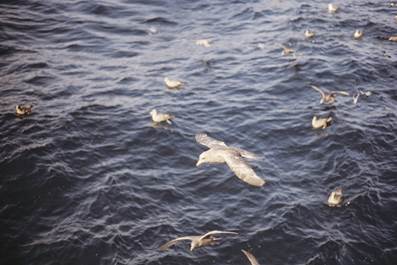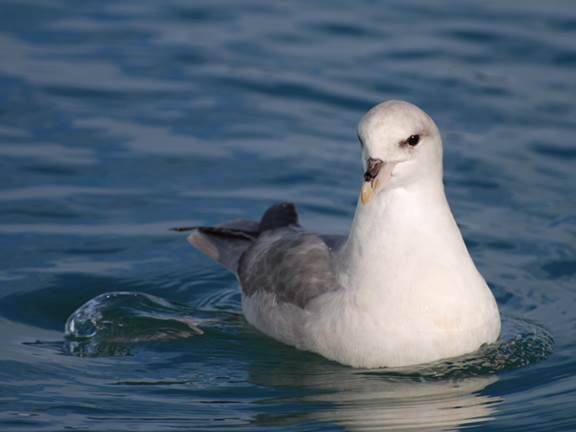his isle abounds with an infinite number of fowl, as Fulmar, Lavy, Falk, Bowger, etc.—A Late Voyage to St. Kilda, Martin Martin (1698).
The northern fulmar is a pelagic bird of the northern oceans – it spends the vast majority of its life at sea and only comes to land to breed. They are related to shearwaters, albatrosses, and storm-petrels that also are pelagic and share the characteristic “tube-nose”on their beaks. The albatross has the tube on the side of the bill vs. on top. These tubes are salt-glands that concentrate and then extrude excess salt from the bird’s body – an adaptation to the extensive time them spend at sea and away from freshwater.
Fulmars have a wingspan of 40-44 inches and they are about 18 inches in length. They feed on shrimp, small fish (such as pollock, cod, and various rockfish), plankton, jellyfish, carrion, and fishing boat waste. Fulmarus – from the old Norse “full” meaning foul, and “mar” meaning gull – and an overall description of their ability described later; glacialis from the Latin for glacier, which refers to their extreme northern range.
Fulmars can be distinguished from gulls by their thick-necked appearance and their flight pattern, which is characterized by stiff-looking wings and alternating between rapid wing beats and long glide periods low over the waves. These birds have two color patters – pale gray on the back with white everywhere else, or a uniform gray. North Pacific birds have slender bills and more color variation than those found in the north Atlantic.
Breeding in North America occurs in Alaska, British Columbia, and in arctic and eastern Canada. Interestingly, 99% of the Alaskan population breeds at only four sites – the Semidi Islands in the Gulf, the Pribilof Islands, and on St. Matthew and Hall Islands in the Bering Sea – all very isolated sites. These birds generally do not breed until they are 8-10 years old. So once they leave their nests as youngsters, they may not be back to land for another decade.
Fulmars have an average life span of about 40 years, which is quite impressive considering the harsh environment in which they live. On the other hand, however – there are not many animals that prey upon them as they are most vulnerable on land and wisely choose inaccessible nest sites. Predators include arctic fox, red fox, and ground squirrels – all were introduced to remote Alaskan islands in the 1800’s. Predatory birds, such as skuas, can prey upon eggs and chicks.
Usually they breed on cliff ledges and lay a single egg in a depression scraped out in the dirt or loose rock/pebbles. Both chicks and adults can expel a rather foul smelling stomach oil up to six feet away as a deterrent to predators. Avian predators can be at risk as the oil can matt their plumage and severely affect flight. You can just see this guy thinking, thinking about it and then disgorging his stomach at the http://ibc.lynxeds.com/video/northern-fulmar-fulmarus-glacialis/oil-spitting-defense
Fulmars are monogamous and form long-standing pair bonds, returning to the same nest site each year. While the female sits on the nest the male will approach with his mouth open and rock his head back and forth, up and down as a prelude to copulation. Breeding occurs in May but females have the ability to store sperm for several weeks after copulation to delay fertilization. A single egg is laid that will hatch in 50-54 days – both sexes will tend the egg and the chick. It will take 75 days for the chick to fledge – during this time period the parents are nocturnal and will avoid activity on moon-lit nights as well.
The Inuit have integrated fulmars into their mythology and there is one dramatic tale of a daughter lured away from her home by fulmars only to discover the tales of a lavish life were a deception – her father takes her back home and plots revenge on the fulmar – he kills it and the bird friends seek retribution
When the other fulmars came home and found their companion dead and his wife gone, they all flew away in search of the fugitives. They were very sad over the death of their poor murdered comrade and continue to mourn and cry until this day
– in the ensuing chase the birds bring up the wrath of the sea – the father tries to throw the daughter overboard as a sacrifice- she grips the boat tightly while he cuts off several of her fingers that then turn into creatures – he allows her to come back in the boat but she seeks revenge when they get back to land and allows the sled dogs to chew off his hands and feet ———- this triangle of bird-father-daughter drama goes on for a bit.
The worldwide population is estimated at 10-12 million with about 2.1 million birds in North America. Their population in the north Atlantic has been steadily increasing and some suggest this is due to the commercial fishing industry where fish are processed at sea and fulmars feed upon the discarded waste.I would see literally thousands of these birds in the Gulf of Alaska, almost anywhere, but particularly off the Shumagin Islands off the Aleutian chain. Because the Japanese trawler I was on for several months processed all fish by hand, and then flash-froze them, once the catch was aboard there was a constant conveyor belt of fish waste from below deck out to the sea. And with it came the parade of petrels, shearwaters, albatrosses, skuas – and the most abundant birds, fulmars.

I would usually finish my data collection before the entire catch was processed. So afterwards I’d clean up and go up on deck to see what was out and about. Sometimes whales, sea lions, or porpoise/dolphin – and always a variety of birds. The fulmars and other birds would glide in a long, continuous loop – banking around the bow of the ship, heading towards the stern, and landing strategically behind the boat in the fish waste plume for a meal and then rejoining the circling loop of birds.
When the seas were steady and the wind calm I’d lean inward against the bridge housing, standing on the narrow side deck and underneath a small overhang of the storage platform above, watching the steady stream of birds go by. If you moved out toward the rail, the flowing river of birds would meander slightly around you. But if you were quiet and still against the side of the bridge, they didn’t seem to mind you and would move closer and lower — and then lower still as they cruised by.
When they were acclimated to my presence and the stream lowered to a few feet above my head, I’d quickly reach up and stroke the under-belly of an unsuspecting fulmar as it passed overhead, and, like some aloof house cat, the current of birds would move just out of reach until I settled back under the overhang, pretending I would not do that again, biding my time.
